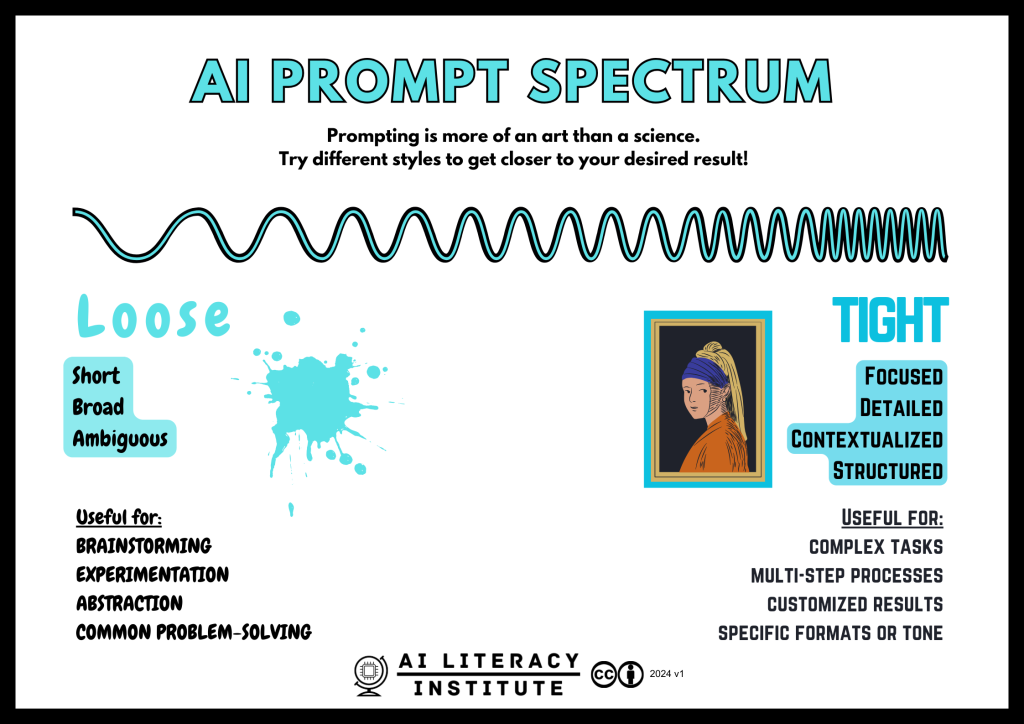Since Generative AI prompting is more of an art than a science, this new resource aims to provide some guidance around the types of prompts you can use.
Instead of judging AI prompts as ‘good’ or ‘bad’, let’s consider labeling them on a spectrum from ‘loose’ to ‘tight’. This framing avoids the judgment aspect and acknowledges that sometimes a short, basic prompt can do the trick, while other times a tighter prompt with more structure and context will get closer to your desired result.
It’s really about aligning the prompt to the setting you’re in, and taking care that the prompt is well-considered and adequately tested (especially in high-risk industries). You can also use follow-up prompts to refine the results if needed.
Here’s the AI Prompt Spectrum resource in PDF and PNG formats:

Loose Prompts
We’ve defined a loose prompt as being short, broad, and/or ambiguous. Many of us start out with loose prompts because we’re still adjusting to the switch away from search engines, which operate on keywords and short phrases. Loose prompts can be useful in some cases, including brainstorming, experimentation, abstraction, and common problem-solving. In fact, we may not want to provide much context or detail if we are looking for novel ideas or want to play with the capabilities of Generative AI.
Examples of loose prompts include:
- Provide some synonyms for “discuss”.
- I’m looking for ideas for a logo for a new business. What icons would be good to show something related to technology?
- Tell me about the city of London, but explain it like you’re a pirate.
- Imagine a world where remote work is the norm. What are the societal implications?
- What can I use to get rid of grease and oil since my regular dishwasher detergent is not getting it all?
These prompts are only one to two sentences long and offer basic information for the AI to use to generate a response.
Tight Prompts
Tight prompts are more focused, detailed, contextualized, and/or structured. A tight prompt enables Gen. AI to really shine in terms of letting us guide its outputs. Tight prompts are useful for complex tasks, multi-step processes, customized results, and specific formats or tone. If we want to use AI to do the things that traditional search engines can’t, we need prompts that provide the kind of detail and contextual information to enable the predictions to go in the direction we need.
Examples of tight prompts include:
- You are an expert tour guide. You need your plan a leisurely walk around somewhere in Auckland New Zealand that ends near a restaurant with a bar. Provide a list of ideas for suburbs and places to walk that meet this criteria.
- You are an experienced museum director. You have received multiple requests from the public to designate a special area for adults and children who have sensory requirements such as having a quiet space. Your options are to repurpose an existing study room used by students or to repurpose a staff meeting room that is used infrequently. Make a list of the pros and cons of each option. Use a professional business tone.
- Write an internal staff newsletter from the human resources department at ABC School. Start with a one paragraph article about how work is proceeding well with the new learning management system, describing some of the benefits. Second, include a section about how the team is adding new training courses on emerging technologies to improve staff capabilities and encourage ongoing professional development. Finally, add a reminder that all systems will be down next month for important upgrades. Frame it in a positive, upbeat tone that expresses the ways the human resources department helps the school be successful in its mission. Include a brief summary of the topics at the beginning, and a thank you from the human resources department staff at the end.
These prompts are longer, provide more detail and context, and follow the structure of a prompt framework (see the CREST Prompt Framework for more information on structured prompts).
The AI Prompt Spectrum attempts to add some concreteness to the concept of prompting with some visual elements and a splash of art. Let us know if you find it useful in a particular context or have ideas for the next version!